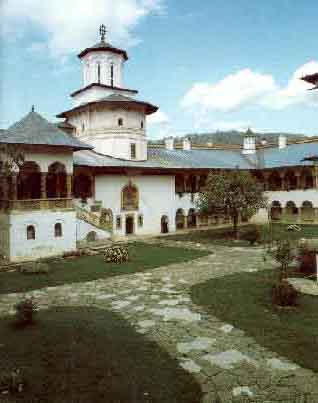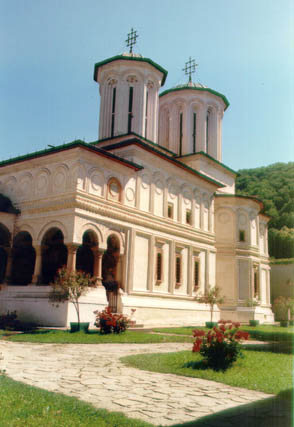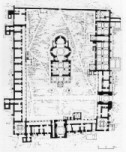|
French
Romanian
THE HUREZI MONASTERYby CORINA POPA

Between 1678 and 1725 Romanian art underwent an artistic and cultural
revival which brought about a specific style, called the 'Brancovan style' after
the name of Romanian Prince Constantin Brâncoveanu (1688 - 1714). This
period in Romanian art represents a last glimpse of the Post-Byzantine art
synthesis and flourishment during an age when Russian, Serbian and Greek art, as
well as that of the Principalities, was still faithful to the Orthodox
tradition.
During this period princes like Șerban Cantacuzino, Constantin
Brâncoveanu, Nicolae Mavrocordat, Metropolitan Bishops like Varlaam,
Theodosie, Antim Ivireanu, bishops like Ștefan Mitrofan, abbeys like
archimandrite John of Hurezi, Ilarion of Cozia and scholars like the Greceanu
brothers, Radu Popescu, Constantin Cantacuzino (the 'High Steward' - high
official in charge of the princely meals, chief of cooks, fishers and gardeners)
is the author of a vast and systematic work of updating the traditional
Byzantine forms and substance. The Byzantine and Orthodox vein of Romanian art
strengthened: the Byzantine Renaissance penetrated the Greek circles at the
princely court, while the wall iconographic painting regained their academic
Paleologue style. The plaster works, the wooden and stone carvings, the
traditional Byzantine embroidery, the Oriental and Italian tissues are
outstandingly sumptuous, revealing Byzantine, Oriental and Baroque motifs. But
even during that Baroque century, the Classical trend in Byzantine art, conveyed
to the Romanian Principalities, pervaded Romanian style prevailingly. The
Oriental and Baroque stone decoration, the precious metal adornments, the stone
and plaster carvings give a special picturesque flavour to the Romanian art of
that age, but these features enriching the art of the epoch would not alter in
any way its post-Byzantine style.
Unique in south-eastern Europe, this
post-Byzantine synthesis found its most authentic expression in the Hurezi
monastery. Situated in the Vâlcea county, in the sub-Carpathian region of
Oltenia, Hurezi has represented beginning with the 14th century when an intense
monastic life went on due to other two monasteries - Cozia and Arnota whose
churches sheltered princely tombs - a complex monastic pile comparable to the
great Athos Mountain monasteries.
 The 'Big Church', namely the main monastery
church, meant to become the tomb of Prince Constantin Brâncoveanu and his
family, should have received his body one day. But he was beheaded, together
with his four sons, on the 15th of August 1714 at the Turkish Sultan's court, as
a 'traitor'. That was how the sultan chose to label the man who had tried to
lure the Vienna and Moscow diplomacies and win them into forming an
anti-Ottoman coalition. Having died a martyr, in tragic circumstances, he could
not be buried in the Hurezi monastery as he had wished it, so his empty
sarcophagus can still be found in the narthex.
This monastic pile, with a hospital and cells in the precinct, with its five churches, outlines a vast
programme - unknown until then and for ever abandoned in Wallachia.
The 'Big Church', namely the main monastery
church, meant to become the tomb of Prince Constantin Brâncoveanu and his
family, should have received his body one day. But he was beheaded, together
with his four sons, on the 15th of August 1714 at the Turkish Sultan's court, as
a 'traitor'. That was how the sultan chose to label the man who had tried to
lure the Vienna and Moscow diplomacies and win them into forming an
anti-Ottoman coalition. Having died a martyr, in tragic circumstances, he could
not be buried in the Hurezi monastery as he had wished it, so his empty
sarcophagus can still be found in the narthex.
This monastic pile, with a hospital and cells in the precinct, with its five churches, outlines a vast
programme - unknown until then and for ever abandoned in Wallachia.
All the churches have been preserved in their original shape. The coherence of the
programme is coupled with the unity of the architectural style: the churches,
rectangular in plan, have high slender turrets whose heights equal the length of
the edifice. The porches opening to the court by arched vaults within the dome
are supported by ten stone piers adorned with late Renaissance motifs.
The clear-cut order the thr elements of this architectural pile built towards the
east-west, the symmetry of the west wing, the facades of the buildings where the
flat surfaces prevail, the square towers on the princely residence and on the
north wing, the arched vaults within the dome, looking the same on the ground
and upper floors - all this create a pleasant atmosphere of harmony and beauty.
This architectural pile has nothing in common with the 16th century Baroque
spirit. The bright white of the plastered facades blurs their entire decoration,
the buildings grow into monuments, as the shade of the porches and turrets holds
the balance.

Monastery Plan
The churches preserve 90 per cent of the original wall paintings.
Painted between 1692 and 1702 by twelve painters led by masters Constantinos and
John, they represent the early Brancovan style in wall painting. These two
artists, who painted also the Lady's Church in Bucharest, built in 1683, were
outstanding promoters of Byzantine Renaissance, both as regards icon and wall
painting, encouraged by the Grecophile circles at Prince Șerban
Cantacuzino's court (1678 - 1688).
The wall painting of Hurezi - a post-Byzantine variant of the academic Paleologue style - is relevant for an
iconographic programme widespread with the Athens and Crete painters of the 16th
and 17th centuries, that penetrated also the Romanian painting: the Scale of
John Climax, Jacob's Scale, The Life of the True Monk, The Ark of Christianity,
The Death of Ephraim, The Annunciation, marriage hymns, The Virgin Mary.
Besides, these painters, helped by renowned iconographers, for instance
archmandrite John - the abbot and great scholar - included in their creations
images of the local saints (Nicodemus from Tismana, Gregory from Decapolis), as
well as characters from the religious novel "Varlaam and Joseph" -
translated in Romanian after 1650 - and "The Life of Saint Constantin"
- the patron of the builder -, and even important topics of a moralising and
eschatological nature: The Day of Judgement, Parables (some of them inspired by
the religious literature traslated and printed in the epoch).
The princely constructions and the churches were endowed with carved wood furniture: pews,
high back chairs, iconostases that borrow the adornmenta of the door frames
where the foliage is in relief or flat, suggesting its connection to the Baroque
metal work.
For ten years master artists, masons, stone cutters and wood
sculptors, icon and wall painters had worked earnestly to perfect this
remarkable monastic pile.
The prince, several boyars and priests made of Hurezi
the main artistic centre of the Râmnic bishopric, so that Polovraci, Mamu,
Surpatele, Cozia and Govora monasteries, as well as Feldelșoiu and Sărăcinești
cloisters were either built or restored and painted by the same artists who at
Hurezi had developed a real stylistic school.
In the 18th century, the Brancovan style had already become a model and a national style spreading all over
Wallachia and reaching Transylvania. This last episode of Romanian mediaeval art
was interpreted in many ways, from the conservative renderings to the bold
originality of folk creations, which made it possible for this style to be still
in use by 1800.
This article is reproduced from:
Corina Popa, Le monastére de Hurezi, in "Denkmäler in Rumänien/Monuments en Roumanie", ICOMOS- Journals of the German National Committee, XIV, 1995, pg. 98-104
Translation: Doina Anca Cornaciu; Text Processing: Bodgan Toader
Web Design: Călin Gligorea
Electronic Publishing: CIMEC, București, ian. 1997.
Last update: April 7th, 2000.
|


 The 'Big Church', namely the main monastery
church, meant to become the tomb of Prince Constantin Brâncoveanu and his
family, should have received his body one day. But he was beheaded, together
with his four sons, on the 15th of August 1714 at the Turkish Sultan's court, as
a 'traitor'. That was how the sultan chose to label the man who had tried to
lure the Vienna and Moscow diplomacies and win them into forming an
anti-Ottoman coalition. Having died a martyr, in tragic circumstances, he could
not be buried in the Hurezi monastery as he had wished it, so his empty
sarcophagus can still be found in the narthex.
This monastic pile, with a hospital and cells in the precinct, with its five churches, outlines a vast
programme - unknown until then and for ever abandoned in Wallachia.
The 'Big Church', namely the main monastery
church, meant to become the tomb of Prince Constantin Brâncoveanu and his
family, should have received his body one day. But he was beheaded, together
with his four sons, on the 15th of August 1714 at the Turkish Sultan's court, as
a 'traitor'. That was how the sultan chose to label the man who had tried to
lure the Vienna and Moscow diplomacies and win them into forming an
anti-Ottoman coalition. Having died a martyr, in tragic circumstances, he could
not be buried in the Hurezi monastery as he had wished it, so his empty
sarcophagus can still be found in the narthex.
This monastic pile, with a hospital and cells in the precinct, with its five churches, outlines a vast
programme - unknown until then and for ever abandoned in Wallachia.
